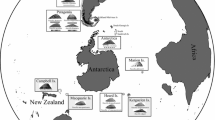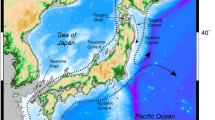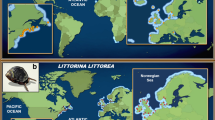Abstract
Genetic structure in the marine environment can show patterns consistent with expectations of life history, geography, and ocean circulation. Organisms with direct development often have low dispersal rates and high potential for local adaptation. Leptasterias is a genus of six-rayed sea stars with direct development and multiple clades forming cryptic species complexes on the eastern Pacific coast. The L. aequalis complex is comprised of several clades found on the central California coast in intertidal and subtidal habitats. Using DNA sequence data from portions of the mitochondrial putative control region and 16S, we show here that a previously undescribed and genetically distinct lineage of Leptasterias inhabits intertidal sites in close proximity to the San Francisco Bay estuary, while geographically separated yet genetically similar clades are located to the north and south. The San Francisco Bay estuary might act as a phylogeographic barrier to dispersal and localized environmental features of San Francisco Bay outflow might shape opportunities for differentiation by further partitioning Leptasterias populations.




Similar content being viewed by others
References
Ament AS (1979) Geographic variation in relation to life history in three species of the marine gastropod genus Crepidula: growth rates of newly hatched larvae and juveniles. In: Stancyk SE (ed) Reproductive ecology of marine invertebrates. University of South Carolina Press, Columbia, pp 61–76
Avise JC (1992) Molecular population structure and the biogeographic history of a regional fauna—a case history with lessons for conservation biology. Oikos 63:62–76
Axelrod DI (1981) Holocene climatic changes in relation to vegetation disjunction and speciation. Am Nat 117(6):847–870
Barbosa SS, Klanten SO, Puritz JB, Toonen RJ, Byrne M (2012) Very fine-scale population genetic structure of sympatric Asterinid sea stars with benthic and pelagic larvae: influence of mating system and dispersal potential. Biol J Linn Soc 108:821–833
Baus E, Darrock DJ, Bruford MW (2005) Gene-flow patterns in Atlantic and Mediterranean populations of the Lusitanian sea star Asterina gibbosa. Mol Ecol 14:3373–3382
Bay RA, Palumbi SR (2014) Multilocus adaptation associated with heat resistance in reef-building corals. Curr Biol 24:2952–2956
Beerli P (2009) How to use MIGRATE or why are Markov chain Monte Carlo programs difficult to use? In: Bertorelle G, Bruford MW, Haue HC, Rizzoli A, Vernesi C (eds) Population genetics for animal conservation. Cambridge University Press, Cambridge, pp 42–79
Beerli P, Felsenstein J (1999) Maximum-likelihood estimation of migration rates and effective population numbers in two populations using a coalescent approach. Genetics 152:763–773
Bernardi G, Talley D (2000) Genetic evidence for limited dispersal in the coastal California killifish, Fundulus parvipinnis. J Exp Mar Biol Ecol 255(2):187–199
Bohonak AJ (1999) Dispersal, gene flow, and population structure. Q Rev Biol 74(1):21–45
Braun C, Fisher R, Bucholz J, D’Avignon M, Jaffe N, Park S, Langhans M, Rosa Barnette S, Salesky M, Gong L, Villegas P, Weinberg R, Chow B, Eberl R, Cohen CS (2016) Leptasterias spp. and sea star wasting disease: a temperature and salinity challenge experiment (poster) 100th Western Society of Naturalists meeting, Monterey, CA. November 13
Burton RS, Lee BN (1994) Nuclear and mitochondrial gene genealogies and allozyme polymorphism across a major phylogeographic break in the copepod Tigriopus californicus. Proc Natl Acad Sci 91(11):5197–5201
Charlesworth B, Nordborg M, Charlesworth D (1997) The effects of local selection, balanced polymorphism and background selection on equilibrium patterns of genetic diversity in subdivided populations. Gen Res 70:155–174
Checkley DM, Barth JA (2009) Patterns and processes in the California Current System. Prog Ocean 83(1):49–64
Chia FS (1966a) Systematics of the six-rayed sea star, Leptasterias, in the vicinity of San Juan Island, Washington. Syst Zool 15:300–306
Chia FS (1966b) Brooding behavior of a six-rayed starfish, Leptasterias hexactis. Biol Bull 130:304–315
Collin R (2001) The effects of mode of development on phylogeography and population structure of North Atlantic Crepidula (Gastropoda: Calyptraeidae). Mol Ecol 10(9):2249–2262
Contreras AN, Cohen CS (2014) Behavioral variation between two clades of Leptasterias spp. Integr Comp Biol 54(suppl 1):e256
Cope JM (2004) Population genetics and phylogeography of the blue rockfish (Sebastes mystinus) from Washington to California. Can J Fish Aquat Sci 61(3):332–342
Cummins PF, Freeland HJ (2007) Variability of the North Pacific current and its bifurcation. Progr Ocean 75:253–265
Dawson MN (2001) Phylogeography in coastal marine animals: a solution from California? J Biogeogr 28:723–736
Dawson MN, Grosberg RK, Stuart YE, Sanford E (2010) Population genetic analysis of a recent range expansion: mechanisms regulating the poleward range limit in the volcano barnacle Tetraclita rubescens. Mol Ecol 19(8):1585–1605
Drummond AJ, Suchard MA, Xie D, Rambaut A (2012) Bayesian phylogenetics with BEAUti and the BEAST 1.7. Mol Biol Evol 29:1969–1973
Eberl R (2013) Phylogeography of the high intertidal isopod Ligia pallasii Brandt, 1833 (Isopoda: Oniscidea) from the Aleutian Islands to Monterey Bay. J Crust Biol 33(2):253–264
Edmands S (2001) Phylogeography of the intertidal copepod Tigriopus californicus reveals substantially reduced population differentiation at northern latitudes. Mol Ecol 10:1743–1750
Ellingson RA, Krug PJ (2006) Evolution of poecilogony from planktotrophy: cryptic speciation, phylogeography, and larval development in the gastropod genus Alderia. Evolution 60:2293–2310
Excoffier L, Laval G, Schneider S (2005) Arlequin (version 3.0): an integrated software package for population genetics data analysis. Evol Bioinform Online 1:47–50
Fisher WK (1930) Asteroidea of the North Pacific and adjacent waters, part 3. Forcipulata. US Nat Mus Bull 76:1–356
Flowers JM, Foltz DW (2001) Reconciling molecular systematics and traditional taxonomy in a species-rich clade of sea stars (Leptasterias subgenus Hexasterias). Mar Biol 139:475–483
Foltz DW (2003) Invertebrate species with nonpelagic larvae have elevated levels of nonsynonymous substitutions and reduced nucleotide diversities. J Mol Evol 57(6):607–612
Foltz DW, Breaux LP, Campagnaro EL, Herke SW, Himel AE, Hrincevich AW, Tamplin TW, Stickle WB (1996) Limited morphological differences between genetically identified cryptic species within the Leptasterias species complex (Echinodermata: Asteroidea). Can J Zool 74:1275–1283
Foltz DW, Nguyen AT, Kiger JR, Mah CL (2008) Pleistocene speciation of sister taxa in a North Pacific clade of brooding sea stars (Leptasterias). Mar Biol 154:593–602
Gomez A, Hughes RN, Wright PJ, Carvalho GR, Lunt DH (2007) Mitochondrial DNA phylogeography and mating compatibility reveal marked genetic structuring and speciation in the NE Atlantic bryozoan Celleporella hyalina. Mol Ecol 16(10):2173–2188
Graham WM, Largier JL (1997) Upwelling shadows as nearshore retention sites: the example of northern Monterey Bay. Continent Shelf Res 17:509–532
Hansen TA (1983) Modes of larval development and rates of speciation in early Tertiary neogastropods. Science 220:501–502
Hays CG (2007) Adaptive phenotypic differentiation across the intertidal gradient in the alga Silvetia compressa. Ecology 88:149–157
Hellberg ME, Balch DP, Roy K (2001) Climate-driven range expansion and morphological evolution in a marine gastropod. Science 292(5522):1707–1710
Hickerson MJ, Cunningham CW (2005) Contrasting quaternary histories in an ecologically divergent sister pair of low-dispersing intertidal fish (Xiphister) revealed by multilocus DNA analysis. Evolution 59(2):344–360
Highsmith RC (1985) Floating and algal rafting as potential dispersal mechanisms in brooding invertebrates. Mar Ecol Prog Ser 25(2):169–179
Hrincevich AW (2002) Patterns of nucleotide substitution within and among mitochondrial gene regions in sea stars (Leptasterias spp.) Doctoral Dissertation, University of Southern Mississippi
Hrincevich AW, Rocha-Olivares A, Foltz DW (2000) Phylogenetic analysis of molecular lineages in a species-rich subgenus of sea stars (Leptasterias subgenus Hexasterias). Am Zool 40(3):365–374
Huelsenbeck JP, Crandall KA (1997) Phylogeny estimation and hypothesis testing using maximum likelihood. Annu Rev Ecol Syst 437–466
Huelsenbeck JP, Ronquist F (2001) MRBAYES: Bayesian inference of phylogenetic trees. Bioinformatics 17(8):754–755
Huyer A (1983) Coastal upwelling in the California Current System. Prog Oceanogr 12(3):259–284
Jablonski D (1986) Larval ecology and macroevolution in marine invertebrates. Bull Mar Sci 39(2):565–587
Jacobs DK, Haney TA, Louie KD (2004) Genes, diversity, and geologic process on the Pacific coast. Annu Rev Earth Planet Sci 32:601–652
Jewett SC, Clark RN, Chenelot H, Harper S, Hoberg MK (2015) Field guide to sea stars of the Aleutian Islands. University of Alaska Fairbanks, Alaska Sea Grant
Johannesson B, Johannesson K (1996) Population differences in behaviour and morphology in the snail Littorina saxatilis: phenotypic plasticity or genetic differentiation? J Zool 240(3):475–493
Jurgens LJ, Rogers-Bennett L, Raimondi PT, Schiebelhut LM, Dawson MN, Grosberg RK, Gaylord B (2015) Patterns of mass mortality among rocky shore invertebrates across 100 km of Northeastern Pacific Coastline. PLoS One 10(6):e0126280
Keever CC, Sunday J, Puritz JB, Addison JA, Toonen RJ, Grosberg RK, Hart MW (2009) Discordant distribution of populations and genetic variation in a sea star with high dispersal potential. Evolution 14:3214–3227
Kelly RP, Palumbi SR (2010) Genetic structure among 50 species of the Northeastern Pacific rocky intertidal community. PLoS One 5(1):e8594. doi:10.1371/journal.pone.0008594
Knowles N, Cayan DR (2004) Elevational dependence of projected hydrologic changes in the San Francisco estuary and watershed. Clim Change 62(1-3):319–336
Knowlton N (1993) Sibling species in the sea. Annu Rev Ecol Syst 24(1):189–216
Krug PJ, Asif JH, Baeza I, Morley MS, Blom WM, Gosliner TM (2012) Molecular identification of two species of the carnivorous sea slug Philine, invaders of the US west coast. Biol Inv 14(11):2447–2459
Kumar S, Tamura K, Nei M (1994) MEGA: molecular evolutionary genetics analysis software for microcomputers. CABIOS 10(2):189–191
Kwast KE, Foltz DW, Stickle WB (1990) Population genetics and systematics of the Leptasterias hexactis (Echinodermata: Asteroidea) species complex. Mar Biol 105(3):477–489. doi:10.1007/BF01316319
Largier JL, Magnell BA, Winant CD (1993) Subtidal circulation over the northern California shelf. J Geophys Res Oceans (1978–2012) 98(C10):18147–18179
Lee HJ, Boulding EG (2007) Mitochondrial DNA variation in space and time in the northeastern Pacific gastropod, Littorina keenae. Mol Ecol 16(15):3084–3103
Leimu R, Fischer M (2008) A meta-analysis of local adaptation in plants. PLoS One 3(12):e4010. doi:10.1371/journal.pone.0004010
Levins R (1968) Evolution in changing environments: some theoretical explorations. Princeton University Press, Princeton
Librado P, Rozas J (2009) DnaSP v5: a software for comprehensive analysis of DNA polymorphism data. Bioinformatics 25(11):1451–1452
Light SF, Carlton JT (2007) The Light and Smith manual: intertidal invertebrates from central California to Oregon, 4th edn. University of California Press, Berkeley
Luebert F, Jacobs P, Hilger HH, Muller LAH (2013) Evidence for nonallopatric speciation among closely related sympatric Heliotropium species in the Atacama Desert. Ecol Evol 4(3):266–275. doi:10.1002/ece3.929
Marko PB (1998) Historical allopatry and the biogeography of speciation in the prosobranch snail genus Nucella. Evolution 52(3):757–774
Marko PB, Palmer AR, Vermeij GJ (2003) Resurrection of Nucella ostrina (Gould, 1852), lectotype designation for N. emarginata (Deshayes, 1839), and molecular genetic evidence of Pleistocene speciation. Veliger 46(1):77–85
Mathews LM, Anker A (2009) Molecular phylogeny reveals extensive ancient and ongoing radiations in a snapping shrimp species complex (Crustacea, Alpheidae, Alpheus armillatus). Mol Phylogenet Evol 50(2):268–281
Mosier AC, Francis CA (2008) Relative abundance and diversity of ammonia-oxidizing archaea and bacteria in the San Francisco Bay estuary. Environ Microbiol 10:3002–3016
O’Connor MI, Bruno JF, Gaines SD, Halpern BS, Lester SE, Kinlan BP, Weiss JM (2007) Temperature control of larval dispersal and the implications for marine ecology, evolution, and conservation. Proc Natl Acad Sci 104(4):1266–1271
Palumbi SR (1994) Genetic divergence, reproductive isolation, and marine speciation. Annu Rev Ecol Syst 25(1):547–572
Parker T, Tunnicliffe V (1994) Dispersal strategies of the biota on an oceanic seamount: implications for ecology and biogeography. Biol Bull 187(3):336–345
Puritz J, Toonen R (2011) Coastal pollution limits pelagic larval dispersal. Nat Commun 2:1–8
Rawson PD, Agrawal V, Hilbish TJ (1999) Hybridization between the blue mussels Mytilus galloprovincialis and M. trossulus along the Pacific coast of North America: evidence for limited introgression. Mar Biol 134(1):201–211
Ricketts EF, Calvin J, Hedgepeth JW (1985) Between Pacific tides. Stanford University Press, Stanford
Rocha LA, Bass AL, Robertson DR, Bowen BW (2002) Adult habitat preferences, larval dispersal, and the comparative phylogeography of three Atlantic surgeonfishes (Teleostei: Acanthuridae). Mol Ecol 11(2):243–251
Rocha-Olivares A, Fleeger JW, Foltz DW (2004) Differential tolerance among cryptic species: a potential cause of pollutant-related reductions in genetic diversity. Environ Toxicol Chem 23:2132–2137
Ronquist F, Teslenko M, van der Mark P, Ayres D, Darling A, Hohna S, Larget B, Liu L, Suchard MA, Huelsenbeck JP (2012) 3.2 Efficient Bayesian phylogenetic inference and model choice across a large model space. Syst Biol 61(3):539–542
Sanford E, Kelly MW (2011) Local adaptation in marine invertebrates. Annu Rev Mar Sci 3:509–535
Selkoe KA, Watson JR, White C, Horin TB, Iacchei M, Mitarai S, Siegel DA, Gaines SD, Toonen RJ (2010) Taking the chaos out of genetic patchiness: seascape genetics reveals ecological and oceanographic drivers of genetic patterns in three temperate reef species. Mol Ecol 19(17):3708–3726
Shaw C, Melroy L, Bair J, Cohen SC (2016) Performance variation in Leptasterias spp. among populations and habitats. Integr Comp Biol 56(suppl 1):e369
Shirley TC, Stickle WB (1982) Responses of Leptasterias hexactis (Echinodermata: Asteroidea) to low salinity. Mar Biol 69(2):155–163
Sjöqvist C, Godhe A, Jonsson PR, Sundqvist L, Kremp A (2015) Local adaptation and oceanographic connectivity patterns explain genetic differentiation of a marine diatom across the North Sea-Baltic Sea salinity gradient. Mol Ecol 24(11):2871–2885
Smith RI, Carlton JT (1975) Light’s manual: intertidal invertebrates of the central California coast, 3rd edn. University of California Press, Berkeley
Smith RJ, Cohen CS (2013) Phylogeography of Leptasterias aequalis near terrestrial runoff sources in the San Francisco Bay Area. Integr Comp Biol 53(suppl 1):e371
Smith MJ, Arndt A, Gorski S, Fajber E (1993) The phylogeny of echinoderm classes based on mitochondrial gene arrangements. J Mol Evol 36(6):545–554
Sotka EE, Wares JP, Barth JA, Grosberg RK, Palumbi S (2004) Strong genetic clines and geographical variation in gene flow in the rocky intertidal barnacle Balanus glandula. Mol Ecol 13(8):2143–2156
Sponer R, Roy MS (2002) Phylogeographic analysis of the brooding brittle star Amphipholis squamata (Echinodermata) along the coast of New Zealand reveals high cryptic genetic variation and cryptic dispersal potential. Evolution 56(10):1954–1967
Strasburg JL, Sherman NA, Wright KM, Moyle LC, Willis JH, Rieseberg LH (2012) What can patterns of differentiation across plant genomes tell us about adaptation and speciation? Philos Trans R Soc Biol 367:364–373
Strathmann RR (1986) What controls the type of larval development? Summary statement for the evolution session. Bull Mar Sci 39(2):616–622
Strathmann RR (1987) Echinoderm larval ecology viewed from the egg. Echinoderm Stud 2:55
Swofford DL (2003) PAUP* Phylogenetic analysis using parsimony (* and other methods). vs 4.0b10. Sinauer Associates, Sunderland
Tamura K, Nei MD, Kumar S (2007) MEGA4: molecular evolutionary genetics analysis (MEGA) software version 4.0. Mol Biol Evol 24:1596–1599
Teacher AGF, Griffiths DJ (2011) HapStar: automated haplotype network layout and visualisation. Mol Ecol Res 11:151–153
Teske PR, Hamilton H, Palsbøll PJ, Choo CK, Gabr H, Lourie SA, Santos M, Sreepada A, Cherry MI, Matthee CA (2005) Molecular evidence for long-distance colonization in an Indo-Pacific seahorse lineage. Mar Ecol Prog Ser 286:249–260
Teske PR, Von Der Heyden S, McQuaid CD, Barker NP (2011) A review of marine phylogeography in southern Africa. S Afr J Sci 107:43–53
Toonen RJ, Grosberg RK (2011) Causes of chaos: spatial and temporal genetic heterogeneity in the intertidal anomuran crab Petrolisthes cinctipes. Phylogeogr Popul genet Crustac 19:75–107
Via S (2012) Divergence hitchhiking and the spread of genomic isolation during ecological speciation-with-gene-flow. Philos Trans R Soc Biol 367:451–460
Vogler C, Benzie JAH, Tenggardjaja K, Barber PH, Wörheide G (2013) Phylogeography of the crown-of-thorns starfish: genetic structure within the Pacific species. Coral Reefs 32(2):515–525
Walsh PS, Metzger DA, Higuchi R (1991) Chelex 100 as a medium for simple extraction of DNA for PCR-based typing from forensic material. Biotechniques 10:506–513
Wares JP, Gaines SD, Cunningham CW (2001) A comparative study of asymmetric migration events across a marine biogeographic boundary. Evolution 55:295–306
Waters JM, Roy MS (2004) Phylogeography of a high-dispersal New Zealand sea-star: does upwelling block gene-flow? Mol Ecol 13(9):2797–2806
Acknowledgements
We thank many Cohen Lab members and volunteers for help with fieldwork, experimental design, and comments on the manuscript including R. Coleman, A. Lai, A. Horwath, B. Chow, C. Craig, J. Spaulding, B. Sheets, D. Clancy. S. Miller, A. Smith, V. Guerra, R. Eberl, and J. Bair. We thank D. Foltz, V. and J. Pearse, R. Everett, C. Mah, J. Largier, R. Grosberg, and M. Dawson for discussion. We appreciate the comments from two anonymous reviewers. This research was supported through the San Francisco State University Research Initiative for Scientific Enhancement (RISE) fellowship (NIH MBRS-RISE: R25-GM059298) and Climate Change Scholar program of SFSU College of Science and Engineering awarded to RJS during her undergraduate studies. Molecular work was conducted at the RTC Gene Lab, supported by RTC, NSF FSML Grant no. 0435044 (CSC) donations from Biolink CCSF, and the SFSU College of Science and Engineering. This is contribution 33 from the SFSU RTC Shared Molecular Facility.
Author information
Authors and Affiliations
Corresponding author
Ethics declarations
Ethical standards
All applicable international, national, and/or institutional guidelines for the care and use of animals were followed.
Conflict of interest
The authors declare that they have no conflict of interest.
Additional information
Responsible Editor: T. Reusch.
Reviewed by B. Miner and an undisclosed expert.
Laura M. Melroy and Riley J. Smith equal contributions to authorship.
Electronic supplementary material
Below is the link to the electronic supplementary material.
Rights and permissions
About this article
Cite this article
Melroy, L.M., Smith, R.J. & Cohen, C.S. Phylogeography of direct-developing sea stars in the genus Leptasterias in relation to San Francisco Bay outflow in central California. Mar Biol 164, 152 (2017). https://doi.org/10.1007/s00227-017-3184-z
Received:
Accepted:
Published:
DOI: https://doi.org/10.1007/s00227-017-3184-z




